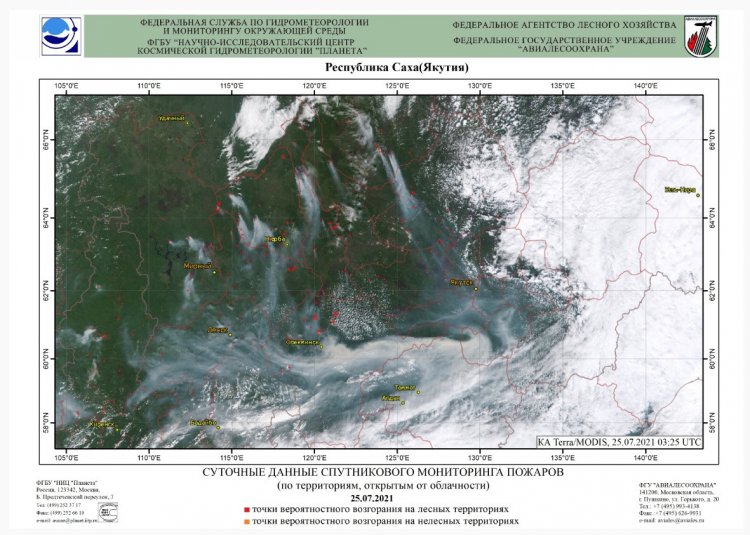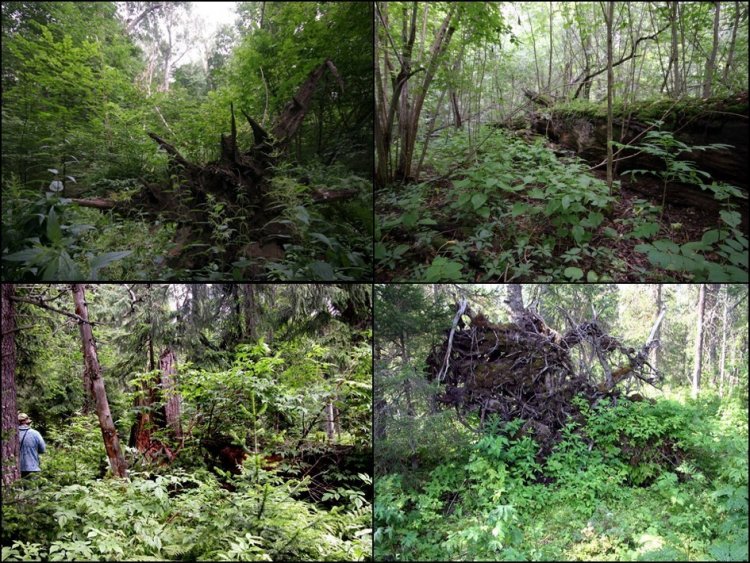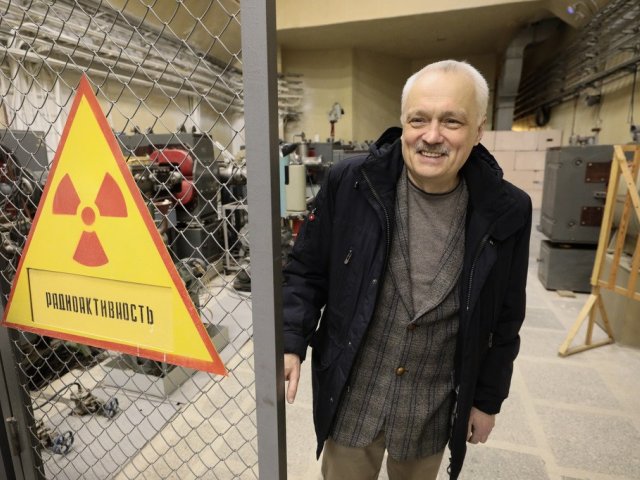Natalia Vasilyevna Lukina, Director of the Center for Ecological Problems and Forest Productivity of RAS, RAS correspondent member
Photo: Nikolay Mokhnachev / Scientific Russia
Forests cover almost a half of Russia’s territory. What functions, apart from economic ones, do forests perform? What is the difference between young planting and perennial natural forest? Where have forest tenants gone? What happens to forest after fire? We have learned it from Director of the Center for Ecological Problems and Forest Productivity of RAS, RAS correspondent member N. V. Lukina.
- Natalia Vasilyevna, tell me, please, about the research that your Center deals with.
- The Center for Ecological Problems and Forest Productivity is a young institution. It was founded just 30 years ago, so we celebrate 30th anniversary. That is why I am grateful to you for the possibility to give interview this very year.
The Center was founded on the initiative of Academician Aleksandr Isayev for the purpose of coordinating the research in several areas: assessment of resource and ecological potential of forests, monitoring of forest ecosystems, preservation of biological diversity and gene resource of forest vegetation, enhancement of recreational and environment-protection functions of forest.
The modern areas of development for our center include: biological diversity, and ecosystemic function of forests, monitoring and forecasts as to the forest ecosystems, and forest policy. Speaking about the first line of activities, it stands to mention that biological diversity is a provider of all forests’ ecosystemic functions. That is why we study the interrelations among biota components, bio-inert components of forest ecosystems and abiotic factors, i.e., how they interrelate with each other and how ecosystemic processes and functions are formed in this interrelationship.
Unfortunately, many people believe that a forest means trees and timber stratum formed by stem alone. However, a forest is actually a very complicated ecosystem including very many components. Natural forests are full of various species of plants, animals and microorganisms. The soil – bio-inert body – is an integral component of forest ecosystems. Making assessments in forests, one should take into account the interaction of soil and biota. Forest soil, phytocenoses, zoocenoses, microbecenoses or individual species are the study objects for many research institutions and higher educational establishments in Russia today. The difference of our research lies in the fact that we work on the ecosystem level. We are interested in the forest ecosystem in general, the formation and behavior of ecosystemic processes supporting the performance of ecosystemic functions that become ecosystemic services when a man appears at the scene. You might hear this strange term that has taken some time to strike root in Russia.
There are many ecosystemic functions and services. We stick to classification Millennium ecosystem assessment that identifies four categories of ecosystemic functions/services: sustaining, supporting, regulating and cultural ones. Supplying with timber is a sustaining service. This category also includes supplying with berries, mushrooms, nuts and medicinal herbs. Today, the emphasis in economy and educational establishments is mostly laid on sustaining services, mainly on supplying with timber.
However, it becomes increasingly clearer that forests are regulating the climate, i.e., perform regulating functions as well. Talking about climatic control, people mainly mean carbon cycle regulation, i.e., the quantity of greenhouse gases that forests can absorb. Carbon markets appeared with the absorption of a ton of carbon estimated at $30-150. Speaking about the absorption of greenhouse gases by forests, the value of Russian forests is estimated by foreign experts at $17 trillion. Thus, a forest means not only timber, berries, mushrooms and nuts, but climatic control as well. However, climatic control is much more than carbon cycle regulation alone. Forests regulate hydrological conditions. 70% of fresh water comes from forest water-collection basins. Unfortunately, the shortage of fresh water in the world is becoming a serious problem today.
Photo: Nikolay Mokhnachev / Scientific Russia
Forests preserve, support and create habitats for biota: 75% of terrestrial biota finds its habitat in forests, i.e., forests perform supporting functions as well. As I have already mentioned, biological diversity is a provider of all ecosystemic functions. Without biological diversity, there will be no ecosystems, as well as no climate control and other function accordingly. All of them repose on biota, which interacts with abiotic factors and creates the environment. The interaction of biota and abiotic factors in forests results in soil-forming processes that perform such an ecosystemic function as regulation and support of natural soil formation.
As for examples of cultural services, we can speak about recreation, health improvement for people, getting knowledge of nature, ecological education, etc. It means that forests form the source of cultural services as well. All these four categories of functions/services are very important, yet unfortunately forests are viewed as the source of timber alone today from the economic point of view. Naturally, timber is a very important material, and we support the development of closed-cycle bio-based economy on the basis of, first of all, forest biomass – a renewable resource. So timber is an essential resource, yet all other functions are no less important. That is why our Center develops the concept dealing with multifunctionality of forests which says that forests perform all ecosystemic functions simultaneously. Making carbon cycle assessments, the experts believe, for example, that there are 640 billion trees in the Russian Federation, and they are capable of sequestrating a certain quantity of carbon. We can certainly count the number of trees and the quantity of greenhouse gases they can absorb, but it is important to bear in mind that all other functions are essential for preserving and maintaining the said function, as it will fail without them. It is the balance among all ecosystemic functions/services that is important. That is why our research, especially the present one, is aimed at assessing this very multifunctionality, the interrelationship among various ecosystemic functions, as well as between the basic biotic components and abiotic factors.
- The summer of 2021 happens to be very hot. It results in many forest fires. How do forests recover after fires? Can they do it on their own, or should people have a finger in the pie? What happens to the soil? Is it considered to be completely infertile? How can people restore forests in such areas?
- You are right to pinpoint attention upon this problem, as forest fires are a serious trouble. Naturally, it is not the problem of Russia alone, as forest fires have become more intensive and frequent in other countries as well. Certainly, there are studies which show and assess the impact of forest fires on soils and other components of ecosystems. Unfortunately, it stands to mention that there are two points of view with regard to forest fires even among the scientific community. The first one views forest fires as a negative factor, i.e., the one having only negative impact on all components. However, there is a different point of view as well. It says that forest fires are necessary and important being a natural factor of forest development dynamics.
We have prepared a serious survey paper that will soon be published in a special issue of Forest Science Issues (Geraskina et al., 2021) devoted to forest fires.
In this article, we show why, in our point of view, people come forward with opinions saying that forest fires are necessary as a factor of forest development dynamics. Forest fires have always occurred, yet their frequency, intensity and scope are increasing today. We have analyzed very many scholar papers, both past and present. Anyway, the majority of scientists incline to the view that fires have a dramatically negative effect on forest biota.
You have asked about their impact on the soil, haven’t you? The forest litter, upper horizon of forest soils, is the habitat for a great number of microorganisms and invertebrates, which support the normal functionality of forests. They are also very important for carbon cycle control and regulation of nutrients, as they are processing the dead soil cover. The fires destroy both these organisms and the very forest litter completely. Even if the surface fire is not so disastrous, they are killed, or remain alive only at some areas of the litter, where their revival begins from afterwards. There are scholar papers showing that the forest litter restoration process takes 120 years minimum.
Photo: Nikolay Mokhnachev / Scientific Russia
Photo: Nikolay Mokhnachev / Scientific Russia
Physical and chemical properties of both the forest litter and mineral horizons that are beneath the litter also change. Tens and hundreds of years are required to restore these properties. The scientists have found out that fires lead to increase in concentration of polycyclic aromatic hydrocarbons, the so-called PAHs, which, as is known, produce carcinogenic and mutagenic effect. That is why forest fires constitute a negative factor for soil biota reducing its species diversity, which later affects ecosystemic functions, as it is biota that controls all these functions. We believe that fires have a negative impact on the forests. The argument quoted by support of forest fires says that such fires, for example, form ruptures in forest canopy layer, open areas, where shade-intolerant species can live. In fact, nature has other mechanisms for creating such open areas in canopy layer to support the living of light-demanding species. These are windfalls, fallouts and formation of window mosaic in natural forests, which are unfortunately few, yet they still exist. Natural mechanisms are in operation there – trees achieve a certain age, get older, die and fall out of the row. The fallout of trees with butt ends and soil occurs. Thus, various elements of mosaic, sort of windows appear producing enough light for shadow-intolerant species and young growth of various trees. Actually, forest fires constitute a negative factor in this respect as well, because the fires embracing large areas create homogeneous environment and destroy the mosaic of habitat, which is required to provide shelter and food for different species and let many species live and function all together on a relatively small area. For instance, such element of the mosaic as windfall resulting from the fallout of trees may serve as habitat for up to 40% of species in this or that forest biogeocenosis. When everything gets burnt on large area and homogeneous conditions are formed, natural mosaic is destroyed, while species diversity reduces. Yes, pyrophytes appear after fires, but they function in the natural forest anyway. In the said article, we tried to substantiate why we can actually do without any fires to let the so-called breakthroughs form in windows in order not to interrupt the natural development of forests.
Today the fires certainly constitute a very serious factor of forest dynamics, or rather the degradation and destruction of forests. We have to combat the forest fires, prevent and extinguish them. Naturally, a man is the guilty party in 90% and more of forest fire cases. Where does the problem lie in? It appears that we are bringing up our children in the wrong way. It is clear that people do not want a forest fire to break out, but building bonfires, burning slash or agricultural burning lead to uncontrolled forest fires. After that, people have to accomplish feats: at present the Aerial Forest Fire Center, Emergencies Ministry and volunteers are combatting fires covering huge territories.
The two approaches complementing each other are important: 1) education and 2) increase in staff size of forest protection service. Unfortunately, the Forest Code of 2006 inflicted a lot of harm to forestry. As a consequence of this document, the authorities have made decisions reducing the staff size of fire protection service by five times if compared to the state of things in the Soviet time. That is why the second way lies in raising the staff size for forest protecting service and foresters, who could make their rounds and monitor the state of forests in their areas. In this case, people will be able to identify the fires at the initial stage, when they can be extinguished with a glass of water as foresters put it. Here is what Georgy Nikolayevich Korovin, director at our Center until 2012, RAS correspondent member, and famous forest pyrologist:
“If the fire cannot be extinguished with a glass of water at the initial stage, we are to face a serious trouble, as it will be very hard, if possible at all, to combat the forest fire.”
- In what way does your Center study the forest dynamics? What methods are used in this work?
Daily data of satellite-based monitoring for forest fires in Yakutia for 25.07.2021
Photo Source: Russian Meteorological Service
- In general, to assess the forest dynamics, the employees of our Center use two methodical approaches: remote and terrestrial methods. Speaking about remote methods, I should mention our close cooperation with the Institute of Space Research (ISR), which has been our strategic partner since the foundation of Center. It is not for nothing that Academician Aleksandr Isayev housed the center at the building of ISR. Our scientist started cooperating with ISR employees at once. ISR has succeeded in working out methods of remote sensing of natural objects on the Earth from space, forest in the first turn. The achievements in this field look serious indeed. The head of Monitoring Department is Yevgeny Arkadievich Lupian, while its Forest Section works under the guidance of Sergey Aleksandrovich Bartalev. We have been successfully cooperating with them for a long time.
Thanks to this cooperation, we have created and put into operation the information system for remote monitoring of forest fires, which is successfully used today. It has become an industrial state information system. It is one of the examples showing successful implementation of forest dynamics monitoring methods. The scientific support of the system is still performed by the Institute of Space research and our Center for Ecological Problems and Forest Productivity. Our institution includes the laboratory of forest monitoring developing remote methods (head of laboratory is Dmitry Vladimirovich Yershov). Thanks to the information system development, we can identify the areas of fire with sufficient certainty and accuracy. Now, we think about making the work more profound with the help of this system, and assessing the damage to forests inflicted by fires more accurately among other things.
In fact, it is a big question how many forests are destroyed by fire today. The forest mortality is estimated now at 1%, yet it is hard to agree with this figure. In Soviet time, domestic pyrologists estimated forest mortality at 15% and even 20%. We believe that we ought to work in closer cooperation with the Federal Forestry Agency and Russian Forest Protection Service to specify these figures and make them more accurate. The understanding of forest mortality areas is very important. It cannot be done without remote sensing, as forests occupy vast territories in our country. These methods allow for developing dynamic mapping, performing data updating with regard to forests, monitoring the processes taking place in the forests on a permanent basis. Our Center works in close cooperation with ISR in this field, and it is one of the leading lines of our activities. We also use images with various spatial resolution – hundreds and tens of meters. We develop the assessment of forest dynamics not only on the nationwide and regional levels, but on the local level as well. We need this data not only for monitoring forest fires, but controlling the state of ecosystems in general as well. Another destructive factor lies, for instance, in the mass reproduction of insects which often follows forest fires. The methods of earth remote sensing (ERS) allow for assessing the influence of these insect reproduction outbreaks on forests and deforestation areas. Naturally, we use these methods in our fundamental research with regard to interrelationship among the components of forest ecosystems. For instance, we study the possibility of using ERS methods for assessing the characteristics of soils and their contribution to carbon sequestration. As far as this line of research is concerned, young scientists are active, while the work related to ERS is performed under guidance of Yegor Aleksandrovich Gavrilyuk.
The share of boreal forests in Russia is estimated at 90%. Talking about carbon and absorption of greenhouse gases by forest, people usually lay emphasis on the trees and forest stand. I would like to call your attention to the fact that soils account for a half of carbon in boreal forests. Since the school time, all of us have known about photosynthesis, CO2, yet we should understand that plants produce fallen leaves and litter which cover the soil surface. Then, the litter decays and the products of litter decomposition are taking part in formation of soils and soil carbon pools. In boreal forest, where the decomposition process is slow, the cycles are hindered so many organic substances get accumulated in soils. Thus, we cannot underestimate the contribution of soils to the budget of carbon in soils. We are actively advancing this area of research in our Center.
Our employees have developed the basic methods for assessing carbon budget of forests and their influence on the concentration of CO2 in atmosphere. We have created standards that allow for assessing detrital pool and carbon flows in Russian forests, as well as identified opportunities for raising the carbon potential of forests by way of implementing large-scale projects in the field of forest cultivation and restoration. This line of research at the Center is guided by chief research fellow Dmitry Zamolodchikov, doctor of biology.
The national cadaster of anthropogenic emissions and absorption by greenhouse gas sinks composed by the Izrael Institute of Global Climate and Ecology (RAS correspondent member Anna Anatolyevna Romanovskaya holds the position of its director) may use only official data, including the one on forests. It is the Federal Forestry Agency that is responsible for forest data. There are various methods of forest monitoring. One of them is the state inventory of forests on the territory of the Russian Federation. Unfortunately, the main emphasis is again laid on forest stand, while soils are not measured with regard to absorption of greenhouse gases by them. Thus, nobody knows the concentration of carbon in soils, while the flows of greenhouse gases are not assessed. It is certainly wonderful that the first cycle of forest inventory survey has been completed, as the older assessments cannot be considered credible. Everybody was looking forward to the conclusion of the first forest inventory cycle to update the database with regard to information about forests. I hope that it will be done for forest stand. As for the soils, there is no progress in this area. The soils are seriously underestimated in Russia. That is why we pay special attention to this component today demonstrating the contribution of soil in carbon sequestration. It is very important for solving the fundamental problems dealing with interrelationship among all components of forest ecosystems that we cope with today. On the other hand, this line of research is of serious practical importance, as it allows for assessing the absorption of greenhouse gases by forest ecosystems a credibly and accurately as possible. Not trees alone, but forest ecosystems in general.
Photo: Nikolay Mokhnachev / Scientific Russia
We have one more component. If you have ever been in boreal forests (spruce and pinewood ones) you might see thick shrub, moss and lichen carpet there. This component is not taken into consideration either in assessment of greenhouse gases absorption. Meanwhile, such large-scale works have been performed in the past under the guidance of famous scientist Anatoly Ivanovich Utkin, also an employee of our center. He coordinated a large-scale program in biological productivity. The results of his work showed that ground vegetation, i.e., shrubs, mosses and lichens, make a great contribution to the annual product of taiga forests accounting for 20% or even 30% in humid conditions of the total output. Today, this work should be performed once again in order to make all these processes clear.
Coming back to investigation methods, I should say that we certainly use the terrestrial methods of forest dynamics research too. Terrestrial methods include, first of all, the work on permanent plots, in test areas, and expeditions aimed at studying various natural zones in forests. Our Center has its own permanent plot and test areas, and we work in close cooperation with other research forestry institutions. Four forestry institutions of RAS function in Russia today: Krasnoyarsk Forest Institute, Forest Institute under the Karelia Research Center, Forestry Institute in Uspenskoye, and our Center.
Many of our employees are the member of Academic Council for Forestry of the Russian Academy of Sciences. The Academic Council for Forestry is incorporated in the structure of RAS academic councils and performs the following functions: assistance to obtaining new knowledge about forests; identification of priorities in development of forest science; development of concepts and programs as to the priority research areas of forest science; analysis of research results and developments dealing with the main lines of forest science development; working out scientific foundation for forest science, sustainable forest control and advanced technologies aimed at innovative development of forestry sector. At present the academic councils of RAS perform expert functions as well.
The Academic Council for Forestry has come forward with a suggestion to create a monitoring network for assessing the carbon budget in forests on the basis of integrating the industrial and scientific monitoring. The Russian Academy of Sciences renders support to us with regard to creation of two-tier network: test areas of extensive monitoring that would let us assess with high accuracy the reserves of carbon in soils and vegetation, as well as their dynamics; and test plots of intensive level for assessing the dynamics of greenhouse gas flows by way of measuring daily, monthly and annual flows. Today, the idea of carbon test fields suggested by the Ministry of Science and Higher Education fits well into our proposal dealing with intensive level of monitoring that will make it possible to measure the flows on these plots. However, the accurate assessment of carbon budget in forests demands both levels of monitoring. We have learned that 69,000 test plots were founded in forests during the first cycle of State Inventory process. It is a serious potential that can be used for creating such a network. The integration among state institutions – the Federal Forestry Agency, Russian Meteorological Service, institutes of the RAS, higher educational establishments and certainly industrial research institutions – would allow for forming a network capable of efficient work. In this case, our figures would look credible for international community, as the ones complying with international requirements. We believe that the key to success lies in inter-agency integration. None of the agencies can cope with this work alone due to various reasons. We have different staff potential in various research areas. Thus, we could obtain credible results by way of cooperation.
Photo: Nikolay Mokhnachev / Scientific Russia
- There is an opinion that not only forest but ocean as well absorbs greenhouse gases. Ocean can boast of larger scale. Can forests really be called lungs of the planet or they would yield precession to the ocean?
- Till recently, it has been believed that the land and ocean account for approximately equal shares of absorbing anthropogenic greenhouse gases. Today scholars say that the ocean’s role is also underestimated, as only abiotic absorption is taken into account, while biotic processes may play even greater part. On the other hand, new scholar papers dealing with absorption by forests come out (Harris et al., 2021) with assessments higher than in previous works too. I would formulate the idea as follows: as the work is still not finished yet, the results are not clear. The papers I have mentioned are new, being published in 2021. The work with regard to oceans has been performed by the intergovernmental oceanographic commission of UNESCO (IOC-R, 2021). They point to gap in the knowledge and show that the role of oceans in greenhouse gas absorption has been underestimated. The new papers on forests also point to many uncertainties with regard to carbon cycle forming mechanisms, gaps and spatial variability among countries. As the assessments feature serious uncertainty, while the problem is of both political and economic nature, I would not dot the i’s and cross the t’s now. I would only say that it is hard to overestimate the role of forests. One should understand that the land and ocean are linked to each other with regard to greenhouse gas flows and carbon cycles. They are not isolated from each other. Talking about the gaps in knowledge we have to state that we have no integrated monitoring in Russia. So far, the measurements in ocean are made separately from the one in forests and other terrestrial ecosystems. Integrated monitoring is needed in order to have reliable figures. In Soviet time, there were individual examples of assessment using the so-called basin approach. The measurements of biogeochemical cycles were made in individual water collecting areas.
These were not large-scale but local studies aimed at finding out how land – forest biogeocenosis for instance – and river or lake are related to each other. The task lay in measuring the substance and energy flows. However, it is an example of local integrated monitoring. Unfortunately, I cannot quote the ones of global integrated monitoring. This kind of monitoring is essential for making assessments and answering your question about the roles of ocean and land. It is also essential for understanding the interrelationship between them, as this interrelationship is vitally important. It will allow us not only make assessments today, but forecast future scenarios in order to understand what would happen in water ecosystems if we cut forests on vast territories, what would happen with element cycles, how to carry out economic activity in the right way. The Russian Ministry of Science and Higher Education called upon the scientists to take part in the activities of working groups for technological initiatives with regard to energy transition. What have we suggested on our part? We have formulated the necessity of creating such integrated monitoring for offering credible assessments as to what happens on the territory of our country today, and what would happen in these or those circumstances.
Photo: Nikolay Mokhnachev / Scientific Russia
Speaking about the role of forests and oceans in greenhouse gas absorption in general, I would say that that these processes in forests still can be controlled, by way of planting trees for instance. However, I would like to stress that this method is not the ultimate way out, if you want to raise the level of greenhouse gas absorption. Sometimes it may lead to reverse effect. For instance, academic periodicals with high rating from time to time publish articles treating the method of planting trees negatively. In Chile, for example, they cut old-growth forests with natural regulation mechanisms, including the ones of greenhouse gas absorption, and plant young trees instead at the same place. Is it good or bad? Naturally, it is bad. So, we should take it into account too. What do I dwell upon control mechanism for? There are methods of forest control all over the world, including our country. There are approaches to forest control aimed at raising the absorption of greenhouse gases by them with performing all other ecosystemic functions. Another question is how actively and efficiently these methods and approaches are used already. I am not sure whether we can suggest such methods and approaches of controlling carbon cycles for the ocean. At least, I do not know about such suggestions. Well, such methods are probably developed for coastal territories and have been developed for forest ecosystems.
We have a large area of abandoned agricultural lands in Russia estimated at 60 and even 70 million hectares. One of our present initiatives lies in forest cultivation, planting new forests on these abandoned agricultural lands. First, they are already covered by young forests, 30–35-year-old, which have grown there spontaneously. In case of respective control over these forests, we can raise their ability of absorbing greenhouse gases. Creating or supporting high-productivity forests, you promote greenhouse gas absorption. This is just an approach to control over these forests. I mean the absorption not only by trees, but soil as well, so we suggest the methods for increasing the fertility of soils. Second, we can assign the areas not covered by forest yet for forest-growing using fast-growing broadleaved tree species. For Russia, using these abandoned agricultural lands for growing forest on them for the purpose of greenhouse gas absorption, on the one hand, and supplying with timber, on the other hand, would look expedient and helpful. It would allow for preserving the virgin old-growth forests – refugiums of biological diversity – as cutting them is pointless and inappropriate. The soils of these forests contain huge amounts of organic carbon, so cutting them will lead to emission of greenhouse gases. Besides, we will destroy the habitat of biota and disrupt the functions of unique forests with high level of biological diversity. What for? Just to produce timber than can be grown? In developed European countries, they have been producing timber for a long time already by way of growing young forests. We, on the contrary, still cut trees in natural forests. That is why the Academic Council of RAS has worked out a new concept of Forest Code. This work was performed under the guidance of Yuri Gagarin, chief research fellow at our Center.
The main concept of the new code lies in transition to forest-growing and preserving and maintaining balance among all ecosystemic function and services. This concept was published in Russian and English languages in Forest Science Issues (Gagarin, 2020). In general, the concept finds receptive audience among many ecologists and biologists. We have discussed it using many platforms. It has not advanced to the high political level so far, yet we started working out this concept following the call on the part of Dmitry Medvedev anyway. In due time, he said that “the Forest Code ought to be revised.” So we developed the concept of a new Forest Code. So far, we do not know if somebody else has performed this kind of work, while we have done it. We are ready to discuss the concept and introduce amendments and addenda if necessary. It is also a very important line of research being relevant to forming the forest policy. At our Center, the area of research devoted to forest policy has been successfully pursued before under the guidance of Aleksandr Isayev and Georgy Korovin.
All ecosystems are vitally important, yet Russia is a forest country – our forests account for 20% of the world’s forest cover, and Russia can boast of the largest area of forests in the world (about 45%) – so we depend upon the forests, and shaping forestry policy is a very important task for us from the viewpoint of science as well.
Photo: Nikolay Mokhnachev / Scientific Russia
- Natalia Vasiliyevna, is the biodiversity in forests changing? You have mentioned the growth in number of insects. Why does it happen?
- Talking about insects, I have meant the outbreak of mass reproduction of insects. After the fire, large quantities of dead wood have been left, which forms an additional trophic and topical resource for insects.
As far as biodiversity is concerned, we should acknowledge that forest degradation is under way in our country. Moreover, it happens not only in Russia, but in the whole world as well. Unfortunately, we witness the extinction of species today. According to forecasts, half of the known plant and animal species will become extinct by the late century, as the man destroys biota’s habitat. In general, points of reference are very important, if we talk about the dynamic of species and species diversity. There are papers that describe the man-made transformation of forests starting from Pleistocene to the present time. The works of chief research fellow of our Center Olga Smirnova and her colleague from Puschino Research Center Maxim Viktorovich Bobrovsky can serve as examples of such research. They studied the dynamics of biogeocenotical cover in Eastern Europe from early Pleistocene (10,000 years ago), during the whole Holocene age and up to the present time. They convincingly demonstrated that the man played the leading part in the process of changing biogeocenotical cover during this period.
Recently, Anthropocene. Points of Reference, a wonderful scholar paper by Maxim Viktorovich Bobrovsky has come out (Bobrovsky, 2021). When did the manmade negative processes actually begin in forests? There are different points of view as to when Anthropocene began. Some scholars believe that its beginning coincides with the start of industrial revolution (late 18th century). However, there are scientists who argue that Anthropocene began thousands and tens of thousands of years ago, so the reference points lay in the remote past.
Talking about impact factors, we should mention the forest fires. It is a very powerful factor that affects the ecosystem. Maxim Viktorovich Bobrovsky notes in his paper, the people learned how to keep the fire burning about 400,000 years ago. They used fire for keeping household and cooking food, but the fire would spin out of control. That is why the fire spread was often a man-made factor, which had a dramatic effect on forests and their biodiversity. We are talking about forests and other terrestrial ecosystems, and the man has seriously changed or even destroyed completely this habitat of various plants, animals and microorganism species.
Openings and fallen trees in broadleaved (top) and taiga (bottom) forests.
Photo: M.V. Bobrovsky/Anthropocene. Points of Reference / Sigma
The composition of the so-called key species, which makes impact on the ecosystem by changing all around them, was also changing. In fact, as research papers devoted to historical biology show, big animals played a very important role in the process in due time. At present such animals are almost missing in the forests. That is why the vision of old virgin forests being dark coniferous ones and spruce groves with wind-broken trees is actually wrong. From the viewpoint of present biologists, the old virgin forests necessarily featured pronounced opening dynamics that I have mentioned before. This opening dynamics was created also by big animals, which contributed to the fall of trees, especially old ones. These were the forests with habitat for all species, both light-demanding and shade-tolerant ones. They could boast of enormous species wealth, the diversity of plant, animal and microorganism species. All species could find habitat there.
Today, we can make out beavers among the big landscape transformers that have remained. They regulate the functioning of landscapes and create habitat for very many species. However, these beaver landscapes reduce in number too. If we take big social hoofed animals, only individual examples, including the ones of introduction can be quoted. For instance, they carry out the introduction of such animals as bison or deer in nature reserves.
The extinction of key species leads to the fact that the habitat for other ones disappears and these species become extinct too – such a chain of negative events. Moreover, the process of extinction is not instant – it happens gradually and therefore is not so noticeable. However, these processes have been launched already. Why do we speak about degradation? It is because increasingly less species remain in the forests. Here is the reason behind negative forecasts saying that half of species will become extinct by late century. So, inventory is a very important research area in general biology, forest biology and ecology. We must know what type of forests, plant and animal species, as well as microorganisms still function today. For instance, chief research fellow of our Center, doctor of biology Lyudmila Borisovna Zaugolnaya and our colleague from Ufa Research Center of RAS, doctor of biology Vasily Borisovich Martynenko worked out unified classification of vegetation for the forests of Russia’s European part. It is based on dominant approach complemented with ecocenotic and floristic analysis. They created an electronic guide for identifying the types of forest in European part of Russia. The guide allows for describing the typological diversity of forests on the basis of traditions of domestic forest phytocenology and foreign approaches to classification of plants.
The equally important line of research that our Center deals with lies in trying to understand the roles of species in creating and maintaining the ecosystemic functions of forests. It is very important. I will quote human genome as an example. It is essential to now many genes a man has, and what these genes are. However, it is equally important to be aware of the function that these genes perform in human organism. The same is true for forest and other ecosystems. It is vitally important to know which species live there, on the one hand, and what function each of them performs, on the other hand. That is why we are publishing an article devoted to the necessity of creating the functional classification of forests in the Lesovedenie magazine (Lukina et al., 2021). The issue is confined to the anniversary of our Center. There is no such classification so far.
We must learn to evaluate the efficiency of performing function by various types of forest. In this case we will be able to assess the interrelationship among them and understand how the balance among various ecosystemic functions can be preserved and maintained. That is why our Center pursues the line of fundamental research as well, though we are yet at the outset of this way so far. However, this research area brings all our scientists together, and we are confident of success.
The interview was taken with the support of the Ministry of Science and Higher Education, as well as the Russian Academy of Sciences.
Reference list for background study of topic:
- Bobrovsky, M.V. Anthropocene. Points of Reference. February 8, 2021.
- Gagarin Y.N. Concept of Draft Bill Forest Code of Russian Federation. Forest Science Issues, V 3. No 3. 2020. Issue: Forest Policy and Legislation of Rusia
- Geraskina, A.P., Tebenkova, D.N., Yershov, D.V., Ruchinskaya, Y.V., Sibirtseva, N.V, Lukina, N.V. Fires as Factor Causing Loss of Biodiversity and Ecosystemic Functions of Forests. Forest Science Issues. 2021 (in print)
- Lukina, N.V., Geraskina, A.P., Kuznetsova, A.I., Smirnov, V.E., Gornov, A.V., Shevchenko, N.E., Tikhonova, E.V., Tebenkova, D.N., Basova, E.V. Functional Classification of Forests: Relevance and Approaches to Development// Forestry, 2021b No 6 (in print).
- Harris, N.L., Gibbs, D.A., Baccini, A. et al. Global maps of twenty-first century forest carbon fluxes. Nat. Clim. Chang. 11, 234–240 (2021). https://doi.org/10.1038/s41558-020-00976-6
- IOC-R. 2021. Integrated Ocean Carbon Research: A Summary of Ocean Carbon Research, and Vision of Coordinated Ocean Carbon Research and Observations for the Next Decade. R. Wanninkhof, C. Sabine and S. Aricò (eds.). Paris,
- UNESCO. 46 pp. (IOC Technical Series, 158 Rev.) doi:10.25607/h0gj-pq41














































